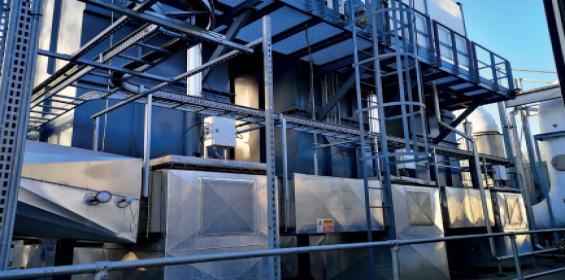Thermal Oxidisers: Efficient odour abatement
Published: 29 August, 2023
Etienne Fourie, Technical Sales Manager at Babcock Wanson, explains the use of Thermal Oxidisers in the food industry
Gas and VOC (Volatile Organic Compounds) effluent produced by food manufacture – primarily meat processing, frying and roasting - have to be treated before being discharged to the atmosphere in order to meet prevailing regulations, including The Solvent Emissions Directive and The Environmental Permitting (England and Wales) Regulations. The most effective and widely used for VOC and odour treatment is Thermal Oxidation. Pollutant gases are heated to a high temperature in a combustion chamber and are fully oxidised before being discharged as a harmless gas.
Thermal Oxidisers are designed and manufactured to recover heat energy externally (Recuperative Oxidisers) or internally (Regenerative Oxidisers). Which of these types is more appropriate is usually dependent upon the composition and delivery volume of the polluted air and the concentration of VOCs. Modern Oxidisers incorporating adsorption technology concentration techniques can bring even the largest air volumes with low solvent loadings within reach of economic operation.
Recuperative Oxidisers
Pollutant gases are heated to a high temperature – typically 700°C - in a combustion chamber for 0.6 – 2.0 seconds to fully oxidise them before being discharged into the atmosphere as a harmless gas. Using Heat Recovery units, energy is recovered from the exhaust stream for reuse in the process or elsewhere, thereby reducing total operating costs.
Recuperative Oxidisers are targeted at industrial process where there is a combination of energy demand and effluent oxidation. These types of Thermal Oxidisers are mainly suitable for high VOC concentrations and lower flow rates.
The key advantages of Recuperative Oxidisers include a quick start up and high energy recovery, plus they are safe and reliable, with full hazard audit.
One Babcock Wanson customer, whose processing facilities are located in a densely populated urban area, has used two COMBI 4000 Recuperative Thermal Oxidisers to remove the frying process odour from the exhaust gas. The pollutant gases are heated to 850°C in the combustion chamber and are fully oxidised before being discharged to the atmosphere as a harmless gas. Each Oxidiser burns up to 4000 kg/h of fryer exhaust and in doing so recovers valuable heat which is fed back to a thermal fluid to heat the production line, thereby recycling the energy back to the process. The recovered heat is also used to produce steam for processing needs and to heat washdown water therefore helping to meet the sites total demand in an efficient manner.
Regenerative Oxidisers
Regenerative Oxidisers are used where there is no requirement for heat recovery or the amount of heat that can be recovered is too small to justify a Thermal Recovery Oxidiser.
The VOC laden air from the process is drawn into the Oxidiser by means of a motor driven centrifugal fan. The effluent is heated in the incoming tower, passed through the combustion chamber and cooled by the exit tower, each of which is filled with specialist ceramic material.
The Regenerative Oxidiser can achieve auto-thermal conditions with very low concentrations of VOC. However, to achieve optimum thermal oxidation of the VOC, the temperature must be between 750 and 950°C, the dwell time of the effluent in the combustion chamber between 0.6 and 1 second and there must be adequate turbulence for efficient mixing of effluent and oxygen.
Regenerative Oxidisers are just as effective as Recuperative Oxidisers and have some added benefits, including lower NOx emissions, reduced gas/fuel consumption, reduced maintenance requirements and, as it is a self-contained plant, it does not produce waste heat.
Moy Park’s Grantham, Lincolnshire, facility benefits from a Regenerative Thermal Oxidiser to provide an effective odour abatement solution for the sites’ frying and oven based cooking processes.
One of Europe’s leading food companies, Moy Park specialises in fresh poultry and complementary convenience food products. Its Grantham premises is a large further processing site for breaded and ready to eat produce featuring six production lines. Both frying and oven cooking methods are used at the site, which has grown rapidly over recent years. With this growth has come the need for improved odour abatement, especially important because of the site’s location close to the town centre.
After a detailed review with the site engineering team, Babcock Wanson recommended replacing the existing Catalytic Thermal Oxidisers with a more effective Regenerative Thermal Oxidiser capable of treating the complete cooking exhaust stream irrespective of the process heat load - an important feature in the fast moving food industry. The exhaust air from the cooking processes is fed through a heated matrix of specialist ceramic honeycombs. It enters the Oxidiser at around 60°C and is heated to 850°C by the ceramics, with a small burner adding the final heat to get the stream to full oxidation temperature. The exhaust stream is treated by passing it through three towers which operate on a fixed rotation thereby ensuring a constant treatment profile. The clean, odour free air is then released to the atmosphere.
An almost unique project in the food industry, the installation has proven to be very reliable with the bare minimum of maintenance or cleaning requirements to meet its round the clock duties.
Up to 25,000 Nm3/h of cooking exhaust is treated at the site with the minimum of natural gas input. It is completely automatic which means production lines can be switched on or off to meet production requirements without having to make adjustments to the Oxidiser settings. A secondary heat recovery system, which will provide up to 200kW of hot water from the clean exhaust air, has also been incorporated, thereby increasing the overall efficiency of the system and reducing overall site gas demand.
Deodorising Oxidisers
Deodorising Oxidisers are designed solely to abate odours and vapour emissions generated by various production processes and are particularly ideal for frying processes, meat processing, rendering and coffee and barley roasting.
Unlike standard Thermal Oxidisers, these are specifically designed plants tailored to meet the particular requirements of each site process.
Odours are processed at a temperature of up to 950°C for approximately 0.8 seconds. A heat recovery boiler recovers energy from the flue gas stream and feeds it back to the process using steam or thermal fluid. Dwell times are adjusted to suit the specific process.
Deodorising Oxidisers have an overall efficiency over 95%.
Conclusion
No food producer willingly pollutes its surrounding atmosphere with unacceptable odours and all are aware that an abatement notice has a potentially devastating impact on their business. Assessing odour and ensuring it is treated appropriately is a priority, especially for premises in built up areas. Thermal Oxidisers provide an effective and cost-efficient method of achieving this.
For further information please visit: www.babcock-wanson.co.uk
https://twitter.com/babcockwanson
https://www.linkedin.com/company/babcock-wanson/






 Siemens’ Financial Services unit (SFS) has appointed Kent Karlsson as sales manager for industry covering Sweden and Denmark.
Siemens’ Financial Services unit (SFS) has appointed Kent Karlsson as sales manager for industry covering Sweden and Denmark.
